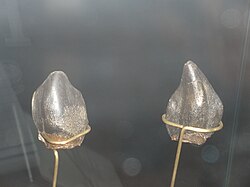History and taxonomy
Moussaye named this genus for a large, broken, worn tooth found in Wilmille, near Boulogne-sur-Mer, and neglected to give it a species name. He thought that it belonged to a theropod like Megalosaurus . [3] Since then, five more teeth have been found and assigned to Neosodon.
Sauvage synonymized it with his tooth species Iguanodon praecursor, [4] [5] which by this time had become mixed up with Edward Drinker Cope's roughly contemporaneous American Morrison Formation genus Caulodon (now a synonym of Camarasaurus ). However, the two are not based on the same type, as "I". praecursor comes from slightly older rocks: the same unnamed Kimmeridgian formation as Morinosaurus . [6] Earlier reviews (Romer, 1956; Steel, 1970) accepted it as a synonym of Pelorosaurus, and considered it a possible brachiosaurid. [7] [8]
In the 1990s, French researchers published on new camarasaurid bones from the same formation. At first, Buffetaut and Martin (1993) suggested that they belonged to Neosodon praecursor, [9] but Le Loeuff et al. (1996) later rejected this, as Neosodon is based only on several teeth, which did not overlap the new material. [10] The latest review accepted both Neosodon and "Iguanodon" praecursor as dubious sauropods. [11] However, Royo-Torres et al. (2006), in their description of Turiasaurus , noted that this tooth was similar to those of their genus and suggested that it could be a turiasaur. [12]
This page is based on this
Wikipedia article Text is available under the
CC BY-SA 4.0 license; additional terms may apply.
Images, videos and audio are available under their respective licenses.












